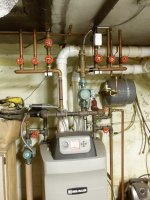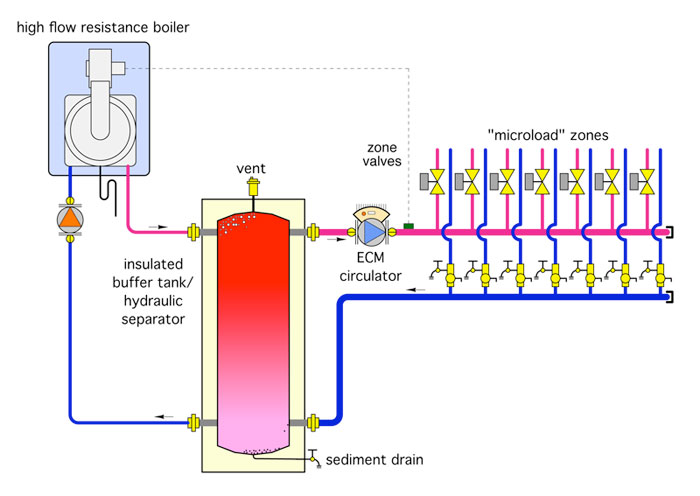Mr. E. Bernstein
New Member
I am a handy homeowner. I can do some heating/plumbing work, but in 2011 I hired a professional installer to replace my heating system which was forced hot air/furnace with separate water heater. The new system is a boiler and indirect DHW. Since the house never had radiators, I asked the installer to use the existing ductwork by connecting the boiler to an air handler. There is one zone valve. This design has worked without problem.
However, there is a modification I would like to make. When the boiler was installed, I asked the installer to put 2 extra taps (3/4") on the supply and return manifold. The third tap is for the air handler (1"). The DHW is not on the manifold. It has its own taps from the boiler pipe (I believe you call that pipe the header). So there are 3 circulators: the boiler, the entire manifold and the DHW. I want to use the extra manifold taps as follows:
While I didn't want to install radiators for the whole house due to cost and damage to floors, walls, etc., there are two areas in the house where I would like to put radiators for supplementary heat. I want to be able to control these radiators independently of any call for heat from the house thermostat. In other words, I want them to have their own thermostat wired to the boiler, not thermostatic valves on the radiators.
I'm pretty sure I can do the plumbing connections myself using pex. I have worked with this before, but I don't know how to make the electrical connections to the boiler. I assume I will need zone valves on the two 3/4" manifold taps. Can I carry out this idea using the existing air handler circulator? I prefer not to have the air handler come on when I want extra heat from the radiators unless there happens at that moment to be a call for heat from the house thermostat. In that case, it doesn't matter if the air handler also comes on.
Besides the wiring, am I missing anything that I need to know? I assume I will need ball valves and check valves in series with each radiator and a separate wall thermostat in each room where I want the two radiators. Another issue I wonder about is how to fill the radiators and tubing before connecting to the manifold. Are any additives needed in the water? The boiler is in an unheated basement but I doubt it ever drops to 32 degrees. Can anyone tell me what I need to know to do this or know where I can find any literature to explain?
It would also help me if someone could explain the exact sequence of events in the boiler when a house thermostat calls for heat from a boiler connected to an air handler. The boiler is WM Ultra 105 ser. 3. It occurred to me I might need a heat exchanger, but it would have to be fairly small to serve just two radiators or 1 for each radiator. I don't think they make them that small. I don't have an idea of the radiator BTUs, but they are wall radiators about 3 foot square. I already have them so I want to use what I have. Thanks
However, there is a modification I would like to make. When the boiler was installed, I asked the installer to put 2 extra taps (3/4") on the supply and return manifold. The third tap is for the air handler (1"). The DHW is not on the manifold. It has its own taps from the boiler pipe (I believe you call that pipe the header). So there are 3 circulators: the boiler, the entire manifold and the DHW. I want to use the extra manifold taps as follows:
While I didn't want to install radiators for the whole house due to cost and damage to floors, walls, etc., there are two areas in the house where I would like to put radiators for supplementary heat. I want to be able to control these radiators independently of any call for heat from the house thermostat. In other words, I want them to have their own thermostat wired to the boiler, not thermostatic valves on the radiators.
I'm pretty sure I can do the plumbing connections myself using pex. I have worked with this before, but I don't know how to make the electrical connections to the boiler. I assume I will need zone valves on the two 3/4" manifold taps. Can I carry out this idea using the existing air handler circulator? I prefer not to have the air handler come on when I want extra heat from the radiators unless there happens at that moment to be a call for heat from the house thermostat. In that case, it doesn't matter if the air handler also comes on.
Besides the wiring, am I missing anything that I need to know? I assume I will need ball valves and check valves in series with each radiator and a separate wall thermostat in each room where I want the two radiators. Another issue I wonder about is how to fill the radiators and tubing before connecting to the manifold. Are any additives needed in the water? The boiler is in an unheated basement but I doubt it ever drops to 32 degrees. Can anyone tell me what I need to know to do this or know where I can find any literature to explain?
It would also help me if someone could explain the exact sequence of events in the boiler when a house thermostat calls for heat from a boiler connected to an air handler. The boiler is WM Ultra 105 ser. 3. It occurred to me I might need a heat exchanger, but it would have to be fairly small to serve just two radiators or 1 for each radiator. I don't think they make them that small. I don't have an idea of the radiator BTUs, but they are wall radiators about 3 foot square. I already have them so I want to use what I have. Thanks
Attachments
Last edited:


